The Network Offers Analysis of NYS Assembly and Senate “One House” Bills
Mar.15.2019
On March 13th, the New York State Assembly and Senate passed their budget bills, and began negotiations with the Executive office with the aim of passing a finalized budget by April 1st. For the latest information on the Prevailing Wage legislation, please visit this page.)
Continue Reading …Notes from Excluded
Dec.01.2016

On October 27th, the Fortune Society, John Jay College’s Prison Re-entry Institute, the Network, and CSH hosted a conference on the obstacles people with criminal justice involvement face trying to access safe, affordable housing and promising practices as to how to overcome them. The sold-out event attracted a deeply engaged audience of 250 people. The Fortune Society’s Stanley Richards, the first formerly incarcerated individual appointed by the City Council to be a member of the NYC Board of Corrections, acted as the host for the day.
New Report from HSC: “New York Nonprofits in the Aftermath of FEGS: A Call to Action”
Feb.29.2016
 In the wake of the March 2015 collapse of Federation Employment and Guidance Services (FEGS), one of the largest social service providers in the sector, the Human Services Council (HSC), which represents organizations across multiple social service sectors including supportive housing, sought to determine to what extent FEGS’ demise was a unique event and to what extent it reflected major sustainability issues within the entire social service sector. The report, “New York Nonprofits in the Aftermath of FEGS: A Call to Action,” determined that while FEGS faced its own challenges, the central issues that led to its collapse are common across all nonprofits in the social service sector, concluding that the sector as a whole is “in crisis.”
In the wake of the March 2015 collapse of Federation Employment and Guidance Services (FEGS), one of the largest social service providers in the sector, the Human Services Council (HSC), which represents organizations across multiple social service sectors including supportive housing, sought to determine to what extent FEGS’ demise was a unique event and to what extent it reflected major sustainability issues within the entire social service sector. The report, “New York Nonprofits in the Aftermath of FEGS: A Call to Action,” determined that while FEGS faced its own challenges, the central issues that led to its collapse are common across all nonprofits in the social service sector, concluding that the sector as a whole is “in crisis.”
Canadian Study: for Every $10 Invested in Supportive Housing for Most Vulnerable, $21 Saved
Oct.08.2014
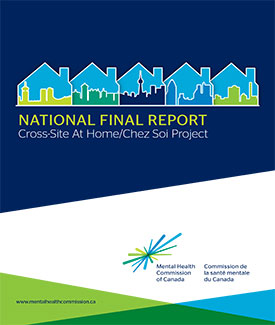 The Mental Health Commission of Canada followed more than 2,000 participants for two years and implemented a five-city supportive housing program using a Housing First (HF) approach using randomized control groups. This is the world's largest trial of HF to date. Housing First is an approach to supportive housing. Their final report was recently released.
The Mental Health Commission of Canada followed more than 2,000 participants for two years and implemented a five-city supportive housing program using a Housing First (HF) approach using randomized control groups. This is the world's largest trial of HF to date. Housing First is an approach to supportive housing. Their final report was recently released.
The outcomes are impressive: investing in supportive housing for those with high needs saves money and leads to better longer term housing outcomes.
In the last six months of the study, 62% of all HF participants were housed all of the time, 22% some of the time, and 16% none of the time. In the control group ("treatment as usual"), 31% of participants were housed all of the time, 23% were housed some of the time, and 46% none of the time. The study also found out more about the small percentage of HF participants who were housed none of the time and developed ideas for additions or adaptations of HF that may work better for them.
For the highest needs users, the top 10% of those served, every $10 invested saved more than $21 in public costs. For moderate needs users, every $10 invested saved nearly $10 in public costs ($9.60 to be precise) -- so the costs of implementing this type of supportive housing were negligible for moderate needs users, and saved twice what they cost for higher needs users.
Continue Reading …Florida Study: Supportive Housing One-Third the Cost of Homelessness
Jun.02.2014
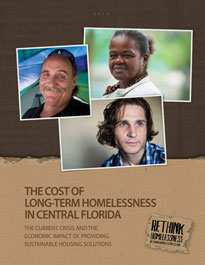 A new study on the cost-effectiveness of supportive housing received significant press coverage last month.
A new study on the cost-effectiveness of supportive housing received significant press coverage last month.
A report from Rethink Homelessness found that providing a homeless person with supportive housing costs taxpayers three times less than leaving a homeless person on the streets. “The Cost of Long-Term Homelessness in Central Florida” echoes the existing research, which has shown that supportive housing both provides formerly homeless individuals with safe, stable homes and saves taxpayer dollars.
The report led to stories on the cost-effectiveness of supportive housing in Vox, Think Progress, PolicyMic, the Orlando Sentinel and other media outlets.
The study looked at a group of 107 chronically homeless individuals in Florida. The researchers found that each person while homeless cost $31,065 per year in inpatient hospitalizations, emergency room fees, incarceration and other systems associated with homelessness. By comparison, the report finds that supportive housing for chronically homeless individuals in Central Florida costs just $10,051 per person per year – a 68% reduction in community costs.
Continue Reading …Oregon Study: Supportive Housing Improves Health, Saves Money
Apr.23.2014
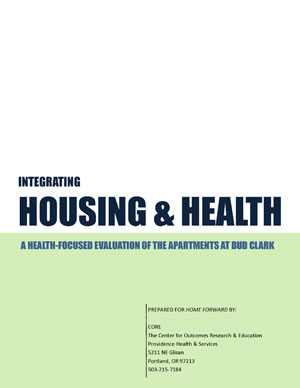 A study released earlier this month reconfirms the economic and health benefits of supportive housing.
A study released earlier this month reconfirms the economic and health benefits of supportive housing.
The report comes out of Oregon, where supportive housing has helped a group of formerly homeless individuals dramatically cut their healthcare expenses. It finds that tenants on Medicaid at Bud Clark Commons (BCC) averaged roughly $2,000 per month in healthcare costs in their year prior to housing. Once housed, that figure dropped to just $899 a month, a 55% decrease. Collectively, the 59 tenants studied at BCC reduced their Medicaid costs by more than $783,000 in just one year. You can read the full document here.
The report concludes:
“The average resident saw a reduction of over $13,000 in annual [Medicaid] claims, an amount greater than the estimated $11,600 it costs annually to house a resident at BCC. Importantly, this reduction in claims was maintained into and beyond the second year of residency, suggesting that supportive housing had a profound and ongoing impact on health care costs for those living at BCC.”
The Center for Outcomes Research & Education (CORE) prepared the report, which is titled “Integrating Housing & Health.” You can read the full study here and a press clip on its findings in Affordable Housing Finance here. We urge you to share the latest report on the positive benefits of supportive housing!
Study: Charlotte Supportive Housing Residence Saves Money, Improves Lives
Mar.26.2014
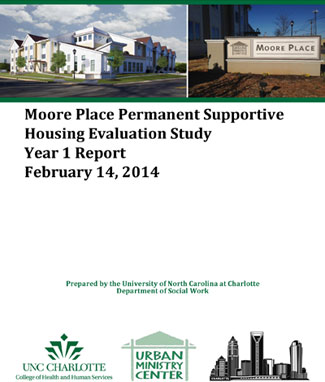 A new report from Charlotte shows that supportive housing can dramatically reduce a formerly homeless person’s use of hospitals, emergency rooms and jails.
A new report from Charlotte shows that supportive housing can dramatically reduce a formerly homeless person’s use of hospitals, emergency rooms and jails.
The study, available here, finds that the 85 tenants of Moore Place have increased incomes, greater social support, fewer arrests and decreased medical expenses within one year of moving into supportive housing. The findings on medical expenses are particularly striking: Tenants billed nearly $1.8 million less in medical expenses during their first year in housing as compared to the previous year. This represents a 70% reduction in hospital and emergency room use.
Moore Place Permanent Supportive Housing Evaluation Study reaffirms what more than two dozen studies have previously shown: that an investment in supportive housing can lead to significant cost savings. The report has already received substantial press coverage from the Huffington Post, the Charlotte Observer and other outlets.
“Housing the homeless not only saves lives – it’s actually cheaper than doing nothing,” concluded the Huffington Post.
Continue Reading …Network Releases Report on NY/NY III Agreement
Feb.27.2014
 The Network has released a new report on the New York/New York III Supportive Housing Agreement, the landmark 2005 commitment to create 9,000 new units of supportive housing in 10 years.
The Network has released a new report on the New York/New York III Supportive Housing Agreement, the landmark 2005 commitment to create 9,000 new units of supportive housing in 10 years.
The report, available here, synthesizes findings from interviews with more than 140 members of the supportive housing community. Taking Stock of the New York/New York III Supportive Housing Agreement: A Community View of the Achievements and Challenges of Implementing the Nation's Largest Supportive Housing Initiative offers an in-depth look at the initiative and explores key areas for growth and improvement for the next great partnership between New York City and State to end homelessness.
"Taking Stock confirms what many of us have known for years: That the New York/New York III Agreement has been a phenomenal engine to house formerly homeless New Yorkers," says Network Executive Director Ted Houghton. "We hope this report will serve as an aid to the supportive housing community, our government partners and other stakeholders as we seek to build upon NY/NY III with a successor agreement. After more than 30 interviews and seven focus groups, we're confident in calling NY/NY III a resounding public policy success."
The Network interviewed an array of stakeholders for this project, including representatives from all 10 of the government signatories of the agreement, supportive housing and shelter providers, NY/NY III tenants, advocates and private sector partners. The goal of the project was to provide a platform for this diverse group of stakeholders to offer feedback on the successes and challenges of the initiative and to elicit their guidance on how best to design future supportive housing agreements.
Continue Reading …New Report: NY/NY III Supportive Housing Saved City $10,100 Per Tenant Per Year
Jan.02.2014
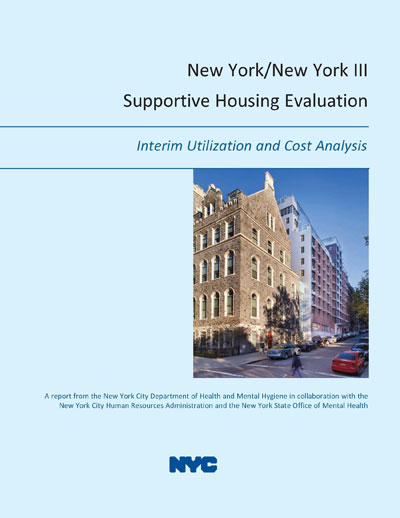 On New Year’s Eve, New York City released the first major report on the cost-savings impacts of supportive housing created under the New York/New York III Supportive Housing Agreement. Reviewing data from the first years of the agreement, the report found that homeless or institutionalized people placed into NY/NY III supportive housing saved taxpayers a net average of $10,100 per person per year. The entire report is available here.
On New Year’s Eve, New York City released the first major report on the cost-savings impacts of supportive housing created under the New York/New York III Supportive Housing Agreement. Reviewing data from the first years of the agreement, the report found that homeless or institutionalized people placed into NY/NY III supportive housing saved taxpayers a net average of $10,100 per person per year. The entire report is available here.
The report’s analysis confirms similar findings by more than 30 studies nationwide that showed how supportive housing can significantly reduce the costly public expenses associated with homelessness. You can read the NYC Department of Health and Mental Hygiene (DOHMH)'s press release for the repot here.
The New York/New York III Supportive Housing Evaluation was conducted by DOHMH in collaboration with the NYC Human Resources Administration (HRA) and the NYS Office of Mental Health (OMH). The evaluation is particularly significant because it compared those found eligible for and placed into NY/NY III housing with a control group made up of those who were also found eligible but did not receive a supportive housing placement. The study looked at two years of costs prior to placement/non-placement and one year post for everyone who was placed or not placed into NY/NY housing between 2007 and 2009.
The study measured public costs associated with participants’ use of shelter, jail, cash assistance, food stamps, state psychiatric care and Medicaid. The report found that, after subtracting the NY/NY III housing and service costs, each NY/NY III tenant housed saves the public an average of $10,100 a year.
The savings occurred across many public systems and varied widely by tenant population, with supportive housing for tenants coming from State-operated psychiatric facilities saving on average an impressive $77,425 per tenant per year. The NY/NY III housing achieved either a complete cost offset or significant savings for all but two of the tenant populations.
Renowned Medical Journal Endorses New York Supportive Housing
Dec.19.2013
 The New England Journal of Medicine has just published a think piece on New York’s efforts to reform Medicaid through supportive housing.
The New England Journal of Medicine has just published a think piece on New York’s efforts to reform Medicaid through supportive housing.
Citing numerous studies, the piece argues that investments in social service programs, including supportive housing, can decrease the amount a society spends on healthcare. The article offers the latest example of an emerging consensus: that supportive housing is healthcare. It was written by three esteemed figures in the field: NYS Department of Health Commissioner Dr. Nirav Shah, NYS Office of Health Insurance Programs Deputy Director Elizabeth Misa and Dr. Kelly Doran of New York University. You can read their perspective here.
The authors stress that supportive housing achieves multiple goals for New York State. Our model helps reduce healthcare costs, improves the quality of care for individuals on Medicaid and improves the overall health of these individuals. On the cost-savings front, the authors lay out a clear argument on the benefits of supportive housing:
"New York Medicaid payments for nursing-facility stays are $217 per day, as compared with costs of $50 to $70 per day for supportive housing. Furthermore, preventing even a few inpatient hospitalizations, at $2,219 per day, could pay for many days of supportive housing […] Studies have shown that the costs of supportive housing are largely offset by resultant savings in services used, mostly from reduced use of the health care system. Some studies of high-risk patients have found that savings exceeded the costs of providing housing, thus yielding a net positive return on investment."
We strongly urge you to read and share this emphatic endorsement of supportive housing!
